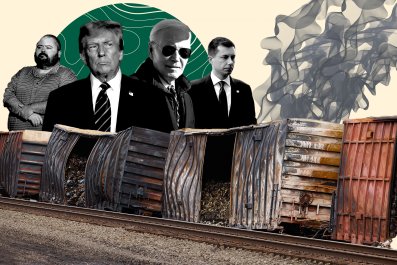When the temperature dropped below 70 degrees, the Strays movie crew had to bring in a heating pad because Benny, the Boston terrier that plays Bug, didn't like his paws on wet grass, Josh Greenbaum, the film's director, said.
"But his performance is great. So, whatever he needs for his process," Greenbaum told Total Film.
It's no surprise that the comedy Strays is taking home more than one PAWSCARS Award. Thirty years after Homeward Bound, the R-rated film relies nearly entirely on dog actors. Three of the four main characters had never acted in a film before and Benny could not be further from his character's tough, street dog persona.
Benny's performance is rivaled by his new friend Reggie, played by a Border terrier named Sophie. The lead of the film, she used head tilts and varying walking paces to convey the emotion of a dog whose naïveté gives way to a newfound independence. In one scene, Reggie crawls under a fence while the other dogs hold it open for him and, in another, Bug pulls off Reggie's bandana. It's a scene that showcases the moment the dogs decide to become a pack with one mission—and one that took several combinations of behaviors (and trainers) to get right.

Sophie didn't always have a pack, though. She was the only dog in her litter and, being a COVID puppy, didn't socialize with other dogs until she was on the film set, which makes her performance even more impressive. "She was like, 'I'm made to do this,'" Mathilde de Cagny, a long-time trainer who worked on Strays, told Newsweek.
A successful performance requires the animal to not only perform the behavior but be engaging. The dog needs to convey the scene's emotion, such as wagging their tail to signal happiness, according to trainer Bill Berloni, who has worked on shows including And Just Like That. The goal is to make the trainer, who's working with hand and noise signals, invisible to the audience.

"You want to make the movie fluid and organic so there's no obvious trainer on site," De Cagny said. "You fade away as a trainer and get the dogs used to working off other actors and other dogs."
In the drama The Creator, a little girl's dog is held at gunpoint while a soldier presses villagers for information. The small brown dog, whose real name is Gollum, is calm in the soldier's arms despite people screaming and crying and the gun just inches from its face. Its facial expressions mimic a dog looking for its owner, who's just feet away.

Red flags in films for Berloni are when a dog is panting, its eyes are darting around or it's doing a hard stare at a trainer who's standing off to the side. It signals the animal might not be happy on set or isn't in the mood to perform at that moment. Sometimes, that's because the animal wasn't able to properly prepare.
Berloni said he could be training a dog to jump out of a window onto a mattress and when they arrive on set, he finds out that there's going to be smoke and fire engines, causing an unsafe environment for the dog. And since the dog can't speak for itself, it falls on the trainer to protect the animals, even if it means potentially sacrificing their own careers.
"I can't tell you how many times I show up on set and they're like, 'Oh, I guess we forgot to tell you that the building's on fire,'" Berloni said. "And the minute you push back, you become difficult to work with."
Trainer Gill Raddings, who's worked on films including Pirates of the Caribbean and Young Victoria, has walked off sets when she found there was an addition to a scene that could endanger the dog because it wasn't properly trained for it. It's a difficult decision to make, but she said dogs need to be given a "fair chance" to get the scene right. It's unreasonable, for example, to ask a dog to lie completely still if there's a fight going on around it without warning. Being vulnerable like that goes against a dog's natural instinct.
It's an experience that's not uncommon, based on the conversations Newsweek had with the trainers. During a nighttime shoot on a film, trainer Megan-Kate Hoover, who's worked on Dark Waters and Extremely Wicked, Shockingly Evil and Vile, had a dog that needed to perform a basic command. But once on set, there was a smell from one of the effects the dog wasn't prepared for, and the animal refused to work. "I still have nightmares about it," Hoover said.

That's not to say dogs can't handle being part of an action-packed film, as showcased by the four-legged actors in John Wick: Chapter 4. Dogs have been a key part of the film series, and Tracker's unnamed dog in the fourth installment is part of the reason why people love the franchise. A protector and companion, the Belgian malinois shows the humanity of the assassin, Tracker, while also being a lethal partner in its own right. Played by five different dogs, depending on the stunt or the scene, director Chad Stahelski had the dogs bond with the stuntmen over a five-month period.
"You have to get to know your friends. So, in order for the dog to be very playful and safe and have the confidence just like a human would, they have to spend time with each individual stuntguy," Stahelski told Collider, an entertainment publication.

If the dog is supposed to be part of a family, Hoover likes the actors to take the dog for a walk or cuddle with the animal before filming. It helps establish a relationship, which makes playing the happy family easier for both the actors and the dog.
But trainers aren't always paid for taking that extra step, and films aren't necessarily encouraging actors to build that relationship. The expectation can be that animals are trained and "should do whatever we tell it," Berloni said.
Without that bonding, though, the dog may look to the trainer for instructions instead of the actor, and the camera picks up on that nuance.
Sometimes, dogs are such a critical part of a film that they're even written into the movie. Pippin wasn't in the original Meg 2 script, but director Jon Turteltaub called having her in it a "must." She garnered such attention for her role in the film that "save Pippin" trended on social media when the trailer left the fate of the dog open-ended.
No Respect for Trainers
While the final cuts of films are what the audience sees, it doesn't begin to capture the work that goes on behind the scenes. When you're an animal trainer, there aren't weekends, life in Hollywood isn't a lucrative business and there aren't any Oscars. They're responsible for training dogs in dozens of behaviors that they execute at any given moment, and caring for their animals on and off set. Trainers can make between $40 and $70 an hour and aren't always paid for the extra weeks of work it takes to prepare an animal for its close-up.
"If I want a credit [on a film] I have to pay for that," Berloni said. "We don't even get acknowledged. Animal trainers are listed on the credits even below caterers. But I stay in this business because I'm an artist, and animal performances can be some of the most powerful, endearing, life-changing things."

Animal trainers can be represented by the Teamsters union, but only for West Coast-based projects, which isn't sufficient coverage, according to Berloni. The Teamsters threw their support behind the writers and actors when they went on strike in the fall, and with films on hiatus, animals also stopped working. But their trainers didn't have the same financial support as the actors and writers, and trainers don't always feel like they're given the respect they deserve.
"We don't make what the writers make," trainer and wrangler Alison Smith, who's worked on Yellowstone and Call of the Wild, told The Washington Post. "It's rough to feel like, as Teamsters, that we're fighting for the writers, but I know a lot of Teamsters are wondering, 'Would the writers fight for us?' We feel like we need it more."
Animals Bring 'A Lot of Magic'
For an average role, Hoover said she has about 10 days to find the right dog, train it and get it ready to film. Dogs need to be "super outgoing and bold," as well as food-driven so they're motivated to perform during their scene, which could take five hours to film—for only a 30-second clip.

Herding breeds are ideal for dog actors because they're working dogs who think it's "super fun," Hoover said. They tend to respond better to commands and genuinely want to be around the humans they're working with.
And some humans really love working with the animals. Hoover praised some of the actors that she's met on set. They've thanked her for letting the dog stay on set to spend time with them in between scenes because "it changes the morale," and gives actors a mental break.
"Animals really bring a lot of magic to a set in general and to the production," Hoover said.
While some trainers are hopeful that, one day, they'll get better working conditions or an Academy Award, not everyone is as confident. When asked if she envisioned a world where the Oscars formally acknowledged animal trainers' work, Raddings said, "not particularly."
Award Eligibility
Newsweek, in recognition of the hard work and significant contributions by dogs and their trainers, is initiating the 2024 PAWSCARS Awards for the best performances by canines in films in the previous year.
Eligibility requirements for consideration include the following criteria: Films had to be domestic and Oscar-eligible, including having a qualifying run in theaters. To be considered for "Best Dog in a Leading Role," the on-air time must be at least 1 minute.









